Can you see what I mean? A multimodal approach to interactional competence in English-Medium Instruction
dc.contributor
Universitat Internacional de Catalunya. Departament de Ciències de l'Educació
dc.contributor.author
Clua Serrano, Mónica
dc.date.accessioned
2021-11-02T18:49:29Z
dc.date.available
2021-11-02T18:49:29Z
dc.date.issued
2021-07-28
dc.identifier.uri
http://hdl.handle.net/10803/672710
dc.description.abstract
Driven by internationalisation, few would argue that English has become the professional lingua franca in
numerous fields, as well as in academic instruction (Dafouz & Nuñez, 2009). One way universities prepare
citizens for the globalised world and labour market, is by giving access to the international community through
programmes taught partially or entirely in English (Cots et al., 2012). This strategy has led to the
implementation of English-Medium Instruction (EMI) in higher education across Europe. However, concerns
have been raised about the effectiveness of English as the lingua franca (ELF) of instruction in achieving
optimal outcomes in higher education contexts (Jenkins, 2011, Seidlhofer, 2009). Therefore, this thesis aims to
investigate the quality of pedagogy in the EMI classroom by looking mainly at how teachers construct the
space for learning and how content knowledge is built. The overarching research objective of this doctoral
dissertation is to analyse teacher-student interactional competence, understood broadly as the successful
collaboration between participants to construct a sphere of shared meaning (Young, 2011), through the
mobilisation of multimodal resources in an English-Medium university lecture where ELF is used for
instruction. This thesis aims (1) to provide a deep understanding of how semiotic resources, in particular
embodied modes, are naturally deployed in ELF-EMI settings, and (2) to explore the affordances and impact
of these modes as meaning-making systems in the context of internationalised higher education. This
phenomenon is brought into focus through three main interrelated theoretical lenses: (1) the university
classroom as an interactional event (Goffman, 1981), (2) multimodality, as a situated meaning-making system
(Jewitt et al., 2016), and (3) interactional competence (Young, 2011). Theoretical depth of interactional
competence and multimodality was sought through the neurocognitive theory of mirror neurons (Gallese,
2001; Iacoboni et al., 2005) as they relate to the Merleau-Pontian notion of corporal intersubjectivity
(Escribano, 2004; Tanaka, 2017). A data corpus of audio-visual material was collected from EMI lectures
given in the English-track Dentistry Program mainly, at the Faculty of Medicine and Health Sciences of a
private Catalan University in the greater Barcelona area. The 5 lecturers that participated in this study are
content specialists in the area of science. At the time of data collection, two lecturers had a CEFR English
proficiency level below B2, whilst the other three lecturers had a level over B2, whereas students registered a
C1+ level on admission to the university programs. Multimodal interactional analysis (Norris, 2004) provided
a systemic approach to organising, producing and analysing the datasets. A fine-grained analysis of classroom
interaction was approached from a perspective of notions inspired by conversation analysis, such as the long
turn (Sacks et al., 1974), the recipient design (Pekarek-Doehler, 2002; Sacks et al., 1974) and participation
frameworks (Goffman, 1981; Goodwin & Goodwin, 2004). The process and products of analysis resulted in
transcripts of talk (Schegloff, 2007) and image vignettes capturing movement trajectories, formats in which
the data are presented. The analysis showed the pivotal role of embodied actions to construct spaces for
learning, manage classroom interaction, elicit participation, transfer speakership rights, provide nuance and
precision to talk, build rapport, express solidarity, establish and mitigate expressions of institutional power,
create a shared classroom experience, evaluate student contributions and co-construct subject matter
knowledge. The results of this thesis illustrate ELF-EMI teachers’ interactional competence through embodied
actions, demonstrating that multimodal resources are not an accessory in pedagogy, but form a
fundamental meaning-making system in the enactment of teaching in internationalised university classrooms,
such as those of this study.
dc.format.extent
274 p.
dc.format.mimetype
application/pdf
dc.language.iso
eng
dc.publisher
Universitat Internacional de Catalunya
dc.rights.license
ADVERTIMENT. Tots els drets reservats. L'accés als continguts d'aquesta tesi doctoral i la seva utilització ha de respectar els drets de la persona autora. Pot ser utilitzada per a consulta o estudi personal, així com en activitats o materials d'investigació i docència en els termes establerts a l'art. 32 del Text Refós de la Llei de Propietat Intel·lectual (RDL 1/1996). Per altres utilitzacions es requereix l'autorització prèvia i expressa de la persona autora. En qualsevol cas, en la utilització dels seus continguts caldrà indicar de forma clara el nom i cognoms de la persona autora i el títol de la tesi doctoral. No s'autoritza la seva reproducció o altres formes d'explotació efectuades amb finalitats de lucre ni la seva comunicació pública des d'un lloc aliè al servei TDX. Tampoc s'autoritza la presentació del seu contingut en una finestra o marc aliè a TDX (framing). Aquesta reserva de drets afecta tant als continguts de la tesi com als seus resums i índexs.
dc.source
TDX (Tesis Doctorals en Xarxa)
dc.subject
Interaction
dc.subject
Interactional competence
dc.subject
Embodied action
dc.subject
Multimodal
dc.subject
English medium instruction
dc.subject
EMI
dc.subject
Gesture
dc.subject
Conversation analysis
dc.subject.other
Sociolingüística
dc.title
Can you see what I mean? A multimodal approach to interactional competence in English-Medium Instruction
dc.type
info:eu-repo/semantics/doctoralThesis
dc.type
info:eu-repo/semantics/publishedVersion
dc.subject.udc
37
dc.contributor.director
Evnitskaya, Natalia
dc.embargo.terms
cap
dc.rights.accessLevel
info:eu-repo/semantics/openAccess


